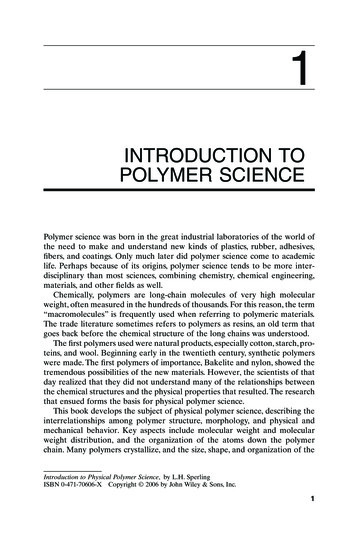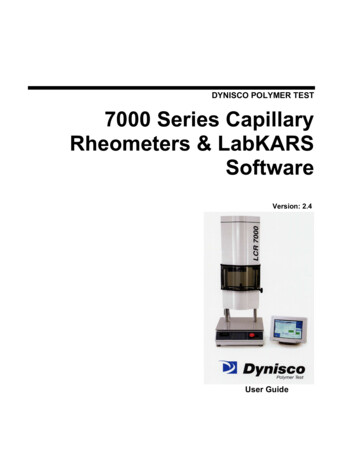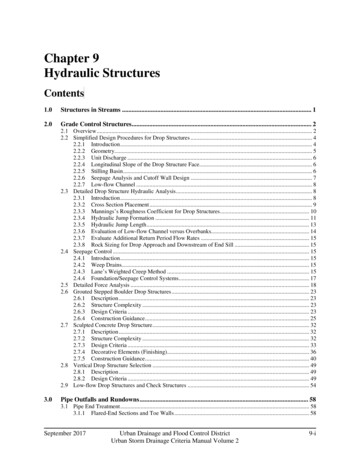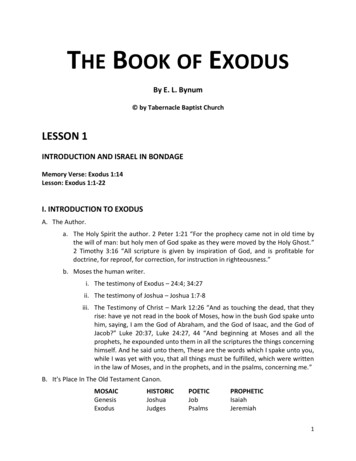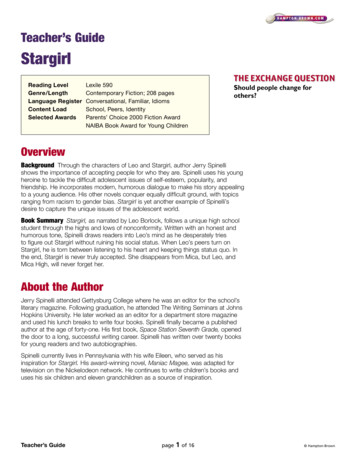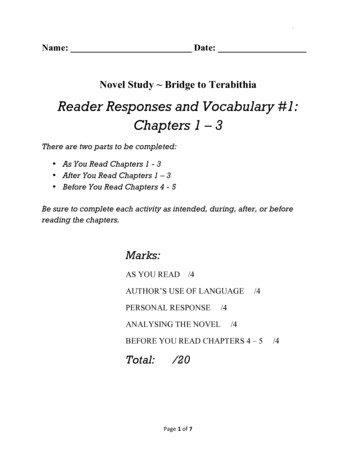
Transcription
CHAPTERS 14/15:POLYMER STRUCTURES,APPLICATIONS, & PROCESSINGISSUES TO ADDRESS. What are the basic microstructural features? How do these features dictate room T tensile response? Hardening, anisotropy, and annealing in polymers. How does the mechanical response compare betweenceramics and metals at elevated temperatures?
POLYMERSPolymers are materials comprised of long molecular chains. Most polymers are carbon based andhave relatively low melting points.Typical plastic extrusion products.Liquid crystals are also polymers.The principle of operation of a LCDSynthetic fabrics are man-madecopies of natural fabrics (Velcro).
POLYMERS A polymer is a macromolecule (long molecules) built of smallcovalently bonded units called monomers (“mer” from the Greekword meros meaning part). These small units are repeated throughout the macromoleculechain. The macromolecules are bonded together by weak Van der Waalsand hydrogen (secondary) bonds, or additional covalent cross-links.
POLMER MICROSTRUCTURE Polymer many mers Covalent chain configurations and strength:Direction of increasing strength
The Polymers: ClassificationThe main classes of polymers are: Natural polymersExample: cellulose and protein, which provide themechanical basis for most plant and animal life Thermoplastics, which soften on heatingExample: polyethylene Thermosets or Resins, which harden when twocomponents are heated togetherExample: an epoxy Elastomers or Rubbers
Natural Polymers Polymers may be natural, such as cellulose, DNA, caoutchouc (India rubber). Living organisms are mainly composed of polymerized amino acids (proteins)nucleic acids (RNA and DNA), and other biopolymers. The most powerful computers -our brains - are mostly just a complex polymermaterial soaking in salty water!Framework of all plant life, as the mainstructure in cell wallThe other main component in cell wallsGelatin, wool, silkSilk fiber is produced by silkworms in a cocoon, to protectthe silk-worm while itmetamorphoses into a moth
Generic Thermoplastics Thermoplastics are made by addingtogether, i.e. “polymerizing”,sub-units (monomers) to form longchain. Many of them are made ofthe unit:repeated many times. The radical R may be hydrogen (PE)or –CH3 (PP) or –Cl (PVC) ormore complicated (as for nylon)
Generic Elastomers (Rubbers) Rubbers are almost-linear polymers with occasional cross-linked in which at roomtemperature the secondary bonds have already melted. However the cross-linked provide “memory” of the material so that it returnsto its original shape on unloading. The common rubbers are all based on a single structure:with the position R occupied by H, CH3 or Cl.
Generic Resins Epoxy: an adhesive and a matrix for different composites is a thermoset. Thermosets are made by mixing of two components (a resin and a harder)which react and harden, either at room temperature or on heating The resulting polymers is usually heavily cross-linked: network polymer!! The cross-links form during the polymerization of the liquid resin and hardener so the structureis almost amorphous.
Polymer Characteristics
THE STRUCTURE of POLYMERS:Hydrocarbon Molecules Most polymers are organic, and formed from hydrocarbon molecules Each C atom has four e- that participate in bonds, each H atom has one bonding e Attachment of different organic groups to the hydrocarbon backbone offers widevariety of possible polymers Examples of saturated (all bonds are single ones) hydrocarbon molecules(of type CnH2n 2)
Compositions and Molecular Structuresfor some CnH 2n 2 CompoundsBoiling Points rise
Unsaturated BondsDouble and triple bonds can exist between C atoms (sharing of twoor three electron pairs). These bonds are called unsaturated bonds.Unsaturated molecules are more reactive
ISOMERSIsomers are molecules that contain the same atoms but in adifferent arrangement. An example is butane and isobutane:
The Polymers Chemistry:Ethylene Polyethylene Polymerization: the reaction of the monomers to form the polymer macromolecule(a) The initial monomer (R);(b) Under certain conditions (T, P) in thepresence of catalyst the double bonds break:forming a highly reactive radical with anunpaired electron, ready for the linking(polymerization)(d-f) the ethylene polymer (polyethylene)chain is limited by the addition ofterminators (e.g. –OH group).
Molecular Weight (1)To create a solid with useful mechanical properties the chain must be long !!One may describe chain length in terms of polymer average molecular weight,which can be defined in several ways:(1) A number-average molecular weight Mn :divide chains into series of size ranges andthen determine the number fraction xi of eachsize rangewhere Mi represents the mean molecular weight ofthe size range i, and xi is the fraction of total numberof chains within the corresponding size range
Molecular Weight (2)(2) A weight average molecularweight Mw is based on the weightfraction wi within the size ranges:Typical distributionof molecular weight
Molecular Weight CalculationExample: average mass of a classStudentWeightmass (lb)11042116314041435180618271918220922510380What is the averageweight of the students inthis class:a) Based on the numberfraction of students ineach mass range?b) Based on the weightfraction of students ineach mass range?
Molecular Weight Calculation (cont.)Solution: The first step is to sort the students into weight ranges.Using 40 lb ranges gives the following table:weightrangenumber ofstudentsmeanweightNiWimass (lb)numberCalculateweightthe number and weightfractionfractionfraction ofstudents in eachxweightwi as follows:rangeimass i W i18810.20.1170.20.1500.3For example:0.294for the 81-120 lb range0.20.23700.00000.00000.0000.10.202totalweight
Molecular Weight Calculation (cont.)weightrangemeanweightWimass (lb)mass .0000.0000.202
Degree of Polymerization (1)The chain length in a polymer can also be described in terms of a degreepolymerization n, which represents an average number of “mer” units in a chainAgain two approaches are possible:Number average nn:where m is a mer molecular weightWeight-average nw:if the polymer is built up of different mer units (copolymer) m is determined from :where fj and mj are the chain fraction and molecular weight for mer j.
Degree of Polymerization (2)Average DP is simply: DP DP P(DP)d(DP)0where P(DP)d(DP) is the fraction of moleculeswith DP values between DP and DP d(DP).And the molecular weight, M, is justM m DPwhere m is the molecular weight of monomerPolymer properties depend on average DP.Example: higher DP higher tensile strength andmelting point!!Question: how one can control DP ?!
MOLECULAR ARCHITECTURE A molecule with one active bond can act as chain terminator butcannot form a link in a chainExample: -OH Monomers which form linear chain have two active bondsthey are bifunctional. Example: thermoplastics have linearnot cross-linked molecules (polyethylene) Monomers with three or more active sites (polyfunctional)form network.Example: thermosetting polymers
Molecular Structure(a) Linear Polymer: end-to-end joining of mers, single, long flexible chains,van-der-Waals and hydrogen bonds hold chains together (polyethylene etc.)(b) Branched Polymer: side branch chains connected to main chain, reduced chainpacking capability and therefore density(c) Cross-Linked Polymers: adjacent chains joined by side chains; synthesis atelevated temperatures promotes cross-linking; non-carbon atoms might be involvedin cross-linking bond (e.g. sulfur in vulcanization, rubber)(b) Network-Polymers: highly cross-linked, tri-functional mers can provide threedimensional cross-linking (epoxy resins, phenyl-formaldehyde)
Stereoisomerism: thermoplastics Polyethylene is the simplest linear chain.By replacing one H atom with a side-group or radical R a vinyl group of polymersExample: R Cl (Polyvinyl chloride) or R CH3 (polypropylene)R gives asymmetry to the repeating units that causes more than one way in which theycan be linked to form a chain – stereoisomerism. Transformation from one in to theother isomer is not possible by bond rotation.isotactic configuration: all R-groups aresituated on the same side of the chainsyndiotactic configuration: R-groups aresituated on alternate sides of the chainatactic configuration: R-groups arearranged in a random position
Geometrical Isomers: rubbers Consider a carbon-carbon double bond in rubbers, which cannot rotate freelywithout breaking a covalent bond, the R group or side-atom can be positionedon the same side (cis) or on opposite sides (trans).cis-polyisoprene (natural rubber) H andCH3 group on the same side, the otherbonds are along the chaintrans-polyisoprene properties differmarkedly from natural rubber (“guttapercha”)
CopolymersCopolymers consist of two or more different mer units. An idea is similar tothis for composites: obtain new polymer properties by combination!!Depending on the polymerization process and relative fraction of mer typesdifferent arrangements are possible.alternatinggraftExample: Styrene-butadiene rubberis a common synthetic copolymerFor automobile tires Styrenerandomblock SBRButadiene
Molecular ShapeThe rotational degree of freedom in the bonds of the polymer chain backboneallows a wide range of molecular shapes for the chain. One example in nature isthe folding of proteins which influences the functionality of the whole structure.ln stepsr (l)1/2nBecause chain-links bend in a random way the average distance, r, betweenstart and end of the chain calculated in the same way as the distance a drunkstaggers from the pub (a “random walk”)
Polymer CrystallinityPacking of the molecular chainsso as to produce an ordered atomic array
MOLECULAR WEIGHT & CRYSTALLINITY Molecular weight, Mw: Mass of a mole of chains. Tensile strength (TS):--often increases with Mw.--Why? Longer chains are entangled (anchored) better. % Crystallinity: % of material that is crystalline.--TS and E often increasewith % crystallinity.--Annealing causescrystalline regionsto grow. % egion
POLYMER CRYSTALLINITY (1)Reminder: Crystalline structure: arrangement of unit cells in a well-definedspatially-ordered manner, which is characterized by translational symmetry Amorphous structures: random arrangement of unitsIn polymers the crystalline order can be established by a regular arrangement ofthe chains. However, since it involves molecules (not atoms) these arrangementsare much more complex.Orthorhombic unit cell (a b c, a g b 90)of polyethylene. Note that the chain moleculesextend beyond the shown unit cell
POLYMER CRYSTALLINITY (2)High density polyethylene is an example of a crystalline polymer. Upon cooling,secondary bonds tend to pull the molecules together into parallel bundles,not perfectly crystalline but not amorphous either. Under some conditions welldefined chain-folded crystals form. The long molecules fold like “computer”paper into a stack with width much less thanlength of the molecule. The folds are not perfectly even, and the tailsof the molecules may not tuck in properly. It is like a badly woven carpet!!However the crystallinity is good enoughto diffract X-rays like a metal crystal
POLYMER CRYSTALLINITY (3)But even the most crystalline of polymers is only 80% crystal!!Bundles and chain folded segments,make it largely crystalline, but these partsare separated by glassy (disordered) regionsFringed-micelle model:small crystalline regions(micelles) in which the chainsare aligned, areembedded in an amorphousmatrix. A single molecule canpass through different regions.
Degree of CrystallinityThus in polymers crystalline and amorphous regions can coexist. Disturbance of thearrangement of the long chains (twists, kinks.) results in the local amorphizationof the polymer. Density of the amorphous phase is lower than that of the crystallinePhase. Thus density and can be used to calculate the degree of crystallinity: c ( s a )% crystallinity x100 s ( c a ) c density of perfect crystalline polymer a density of completely amorphous polymer s density of analyzing partially crystalline polymer
Semi-crystalline PolymersSpherulitesurface Some semicrystallinepolymers formspherulite structures Alternating chainfolded crystallites andamorphous regions Spherulite structure forrelatively rapid growthrates
Degree of CrystallinityDegree of crystallinity is determined by: Rate of cooling during solidification: time is necessary for chains to move andalign into a crystal structure Mer complexity: crystallization less likely in complex structures, simplepolymers, such as polyethylene, crystallize relatively easily Chain configuration: linear polymers crystallize relatively easily; branchesinhibit crystallization; network polymers are almost completely amorphous;cross-linked polymers can be both crystalline and amorphous Isomerism: isotactic, syndiotactic polymers crystallize relatively easily geometrical regularity allows chains to fit together; atactic difficult to crystallize Copolymerism: easier to crystallize if mer arrangements are more regular –alternating and block can crystallize more easily as compared to random and graftMore crystallinity: higher density, more strength, higher resistance to dissolutionand softening by heating
Crystallization of Different Materialse.g. in metals, when liquid crystallizes to a solid,there is a sharp sudden decrease of volume !!The random arrangement of the atoms in the liquidchange discontinuously (same for viscosity, etc.)Crystalline polymers behave similarly:have a fairly well-defined melting point at whichvolume (a swell as viscosity) changes rapidly,blurred by the range of molecular weightsWhen a polymer solidified to a glass the meltingpoint disappears completely, but new so-calledglass temperature at which the free volumedisappears can be defined and measured
Melting & Glass Transition Temps.What factors affect Tm and Tg? Both Tm and Tg increase withincreasing chain stiffnessChain stiffness increased bypresence of1. Bulky side groups2. Polar groups or side groups3. Chain double bonds andaromatic chain groupsRegularity of repeat unitarrangements – affects Tm only
Polymer CrystalsThin crystalline platelets grown from solution. These crystals are regularly shapedthin platelets 10 nm thick/ 10mm long. Typically they form multilayer structuresPolyethylene single crystal(TEM photo)Single crystals – only for slow andcarefully controlled growth rates0.5 μmThe microstructure can be describedby the chain-fold model: The chainscross the platelet several times andare folded back and forth onthemselves. The average chainlength is much greater than thethickness of the crystallite
SpherulitesOften the crystalline platelets organize themself into spherulites;spherical aggregates of the lamellar crystallites ( 10nm thick), separated byamorphous material.The growing ends of a small bundle crystallites trap amorphous material betweenthem, wedging them apart. More crystallites nucleate on the bundle and theysplay out as they grow. The splaying continues until the crystallites bend back onthemselves and touch.
SpherulitesTEM micrograph of spherulitestructure in natural rubberSpecimen (x 20,000).A micrographin cross-polarized light ofspherulite structure ofPolyethylene (x 500).
Mechanical Properties
Mechanical Properties of Polymers –Stress-Strain Behaviorbrittle polymerplasticelastomerelastic moduli– less than for metals Fracture strengths of polymers 10% of those for metals Deformation strains for polymers 1000%– for most metals, deformation strains 10%
TENSILE RESPONSE:BRITTLE & PLASTIC
Yield and Tensile StrengthPolymerMetal
PREDEFORMATION BY DRAWING Drawing.--stretches the polymer prior to use--aligns chains to the stretching direction Results of drawing:--increases the elastic modulus (E) in thestretching dir.--increases the tensile strength (TS) in thestretching dir.--decreases ductility (%EL) Annealing after drawing.--decreases alignment--reverses effects of drawing. Compare to cold working in metals!
TENSILE RESPONSE: ELASTOMERCASE Compare to responses of other polymers:--brittle response (aligned, cross linked & networked case)--plastic response (semi-crystalline case)
THERMOPLASTICS VS THERMOSETS Thermoplastics:--little cross linking--ductile--soften w/heating--polyethylene (#2)polypropylene (#5)polycarbonatepolystyrene ister,rubberFig. 16.9toughplasticpartiallycrystallinesolidMolecular weight Thermosets:--high cross linking(10 to 50% of mers)--hard and brittle--does NOT soften w/heating--vulcanized rubber, epoxies,polyester resin, phenolic resinTmTg
T AND STRAIN RATE: THERMOPLASTICS Decreasing T.--increases E--increases TS--decreases %EL Increasingstrain rate.--same effectsas decreasing T.
Time-Dependent Deformation Stress relaxation test:-- strain in tension to eoand hold.-- observe decrease instress with time.tensile testeostrainσ(t)time Relaxation modulus: There is a large decrease in Erfor T Tg.510Er (10 s) 3in MPa10rigid solid(small 0viscous liquid-310 (large relax)60 100 140 180 T(ºC)Tg Representative Tg values ( C):PE (low density) - 110PE (high density) - 90PVC 87PS 100PC 150
Crazing During Fracture ofThermoplastic PolymersCraze formation prior to cracking– during crazing, plastic deformation of spherulites– and formation of micro voids and fibrillar bridgesaligned chainsfibrillar bridgesmicro voidscrack
Processing of Plastics Thermoplastic– can be reversibly cooled & reheated, i.e. recycled– heat until soft, shape as desired, then cool– ex: polyethylene, polypropylene, polystyrene. Thermoset– when heated forms a molecular network(chemical reaction)– degrades (doesn’t melt) when heated– a prepolymer molded into desired shape, thenchemical reaction occurs– ex: urethane, epoxy
Processing Plastics – Compression MoldingThermoplastics and thermosets polymer and additives placed in mold cavity mold heated and pressure applied fluid polymer assumes shape of mold53
Processing Plastics – Injection MoldingThermoplastics and some thermosets when ram retracts, plastic pellets drop from hopper into barrelram forces plastic into the heating chamber (around thespreader) where the plastic melts as it moves forwardmolten plastic is forced under pressure (injected) into the moldcavity where it assumes the shape of the moldBarrel54
Processing Plastics – Extrusionthermoplastics plastic pellets drop from hopper onto the turning screwplastic pellets melt as the turning screw pushes themforward by the heatersmolten polymer is forced under pressure through theshaping die to form the final product
Processing Plastics – Blown-FilmExtrusion
Polymer Types – FibersFibers - length/diameter 100 Primary use is in textiles. Fiber characteristics:– high tensile strengths– high degrees of crystallinity– structures containing polar groups Formed by spinning– extrude polymer through a spinneret (a diecontaining many small orifices)– the spun fibers are drawn under tension– leads to highly aligned chains - fibrillar structure
Polymer Types – Miscellaneous Coatings – thin polymer films applied to surfaces –i.e., paints, varnishes– protects from corrosion/degradation– decorative – improves appearance– can provide electrical insulation Adhesives – bonds two solid materials bonding types:1. Secondary – van der Waals forces2. Mechanical – penetration into pores/crevices Films – produced by blown film extrusionFoams – gas bubbles incorporated into plastic
Advanced PolymersUltrahigh Molecular Weight Polyethylene (UHMWPE) Molecular weight ca. 4 x 106 g/mol Outstanding properties––––high impact strengthresistance to wear/abrasionlow coefficient of frictionself-lubricating surface Important applications– bullet-proof vests– golf ball covers– hip implants (acetabular cup)UHMWPE
Advanced PolymersThermoplastic ElastomersStyrene-butadiene block mponentdomain
Summary Limitations of polymers:-- E, σy, Kc, Tapplication are generally small.-- Deformation is often time and temperature dependent. Thermoplastics (PE, PS, PP, PC):-- Smaller E, σy, Tapplication-- Larger KcTable 15.3 Callister &-- Easier to form and recycleRethwisch 9e: Elastomers (rubber):-- Large reversible strains!Good overview Thermosets (epoxies, polyesters):of applications-- Larger E, σy, Tapplicationand trade namesof polymers.-- Smaller Kc
Summary Polymer Processing-- compression and injection molding, extrusion,blown film extrusion Polymer melting and glass transition temperatures Polymer applications-- elastomers-- fibers-- coatings-- adhesives-- films-- foams-- advanced polymeric materials
form network. Example: thermosetting polymers . Molecular Structure (a) Linear Polymer: end-to-end joining of mers, single, long flexible chains, van-der-Waals and hydrogen bonds hold chains together (polyethylene etc.) (b) Branched Polymer: side branch chains connected to main chain, reduced chain
